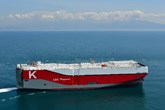Port of Rotterdam tariffs to increase
Published by David Rowlands,
Editor
LNG Industry,
The Port of Rotterdam has announced that the tariffs paid by sea-going vessels in Rotterdam will increase by 0.5% in 2016, which is half of the past year’s rate of inflation. This change will be made in accordance with a 3-year agreement on changes to port tariffs that was made in 2014 amongst Deltalinqs, VRC, VNPI and the Port Authority.
In addition to this, the Port Authority wants to encourage specific sectors, such as container transhipment, through a variety of targeted measures. Once the containers have been delivered via a sea-going vessel, they are transported to another European port by sea. The port tariff for one such container is approximately €8, and the current discount on each deepsea container will be increased from €2.50 to €3.75 in 2016.
Meanwhile, for feeder containers, the current discount of €2.50 per container will be unchanged in 2016 and 2017. These discounts represent an effort by the Port Authority to increase transhipment cargo via the Port of Rotterdam. In addition to this, the incentive is retained for container vessels to travel to Rotterdam twice when visiting Europe. Whenever deepsea container vessels, which are sailing to and from different continents, visit the port a second time, the tariff is 25% of the usual rate, encouraging large, heavily stocked container vessels to call at Rotterdam in order to unload part of their cargo, and then dock at various other European ports before finally returning to Rotterdam whilst en route to Asia, so that they can leave Europe fully laden.
For tankers carrying crude oil, meanwhile, the tariff in 2016 will remain at 1.5% below inflation in conformity with the 3-year agreement made with the VNPI. This represents a fall of 0.5% in the tariff in 2016.
The Environmental Ship Index (ESI), which is the current discount for clean ships, will continue. Any ship that scores 31 points on the index will continue to receive a discount of 10% on the port tariff’s ship section. In addition, the discount is doubled if the ships are shown to have relatively low nitrogen emissions. A ship, therefore, must score a minimum of 31 points on the ESI’s NOx emission section.
Rotterdam and the Drechtsteden have been classified as a single area since 1 January 2015 to allow skippers to need just one subscription. Furthermore, the environmental discount will continue and the inland port tariff system will be made more customer-friendly. This means that, in 2016, tariffs will be linked to the inflation index at half the rate of inflation, and up to a maximum of 1% per annum. In turn, this means that, in 2016, the inland port tariffs will be linked to the index at 0.5%.
Edited from press release by David Rowlands
Read the article online at: https://www.lngindustry.com/lng-shipping/09112015/port-of-rotterdam-tariffs-to-increase-1598/
You might also like
‘K’ Line receives LNG-fuelled car carrier
An LNG-fuelled car carrier with a capacity of 6900 vehicles has been delivered to Kawasaki Kisen Kaisha, Ltd.

